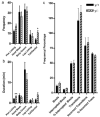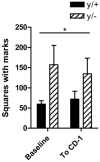Mecp2 truncation in male mice promotes affiliative social behavior
- PMID: 21909962
- PMCID: PMC5843946
- DOI: 10.1007/s10519-011-9501-2
Mecp2 truncation in male mice promotes affiliative social behavior
Abstract
Mouse models of Rett syndrome, with targeted mutations in the Mecp2 gene, show a high degree of phenotypic consistency with the clinical syndrome. In addition to severe and age-specific regression in motor and cognitive abilities, a variety of studies have demonstrated that Mecp2 mutant mice display impaired social behavior. Conversely, other studies indicate complex enhancements of social behavior in Mecp2 mutant mice. Since social behavior is a complicated accumulation of constructs, we performed a series of classic and refined social behavior tasks and revealed a relatively consistent pattern of enhanced pro-social behavior in hypomorphic Mecp2 (308/Y) mutant mice. Analyses of repetitive motor acts, and cognitive stereotypy did not reveal any profound differences due to genotype. Taken together, these results suggest that the mutations associated with Rett syndrome are not necessarily associated with autism-relevant social impairment in mice. However, this gene may be a valuable candidate for revealing basic mechanisms of affiliative behavior.
Figures







References
-
- American Psychiatric Association. Diagnostic and Statistical Manual of Mental Disorders. 4th. 2000. Diagnostic criteria for 299.00 Autistic Disorder. text revision (DSM-IV-TR)
-
- Amir RE, Van den Veyver IB, Wan M, Tran CQ, Francke U, Zoghbi HY. Rett syndrome is caused by mutations in X-linked MECP2, encoding methyl-CpG-binding protein 2. Nat Genet. 1999;23(2):185–188. - PubMed
-
- Bienvenu T, Carrie A, de Roux N, Vinet MC, Jonveaux P, Couvert P, Villard L, Arzimanoglou A, Beldjord C, Fontes M, Tardieu M, Chelly J. MECP2 mutations account for most cases of typical forms of Rett syndrome. Hum Mol Genet. 2000;9(9):1377–1384. - PubMed
Publication types
MeSH terms
Substances
Grants and funding
LinkOut - more resources
Full Text Sources
Medical
Molecular Biology Databases

